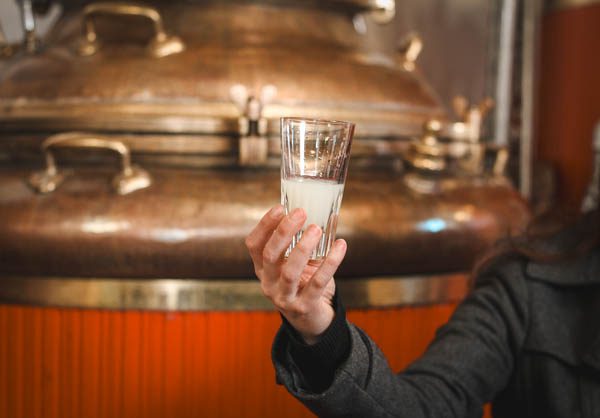
From a medicinal marvel to conspiracy-fueled chaos and its quiet comeback
Absinthe has always been a bit of an enigma—a spirit steeped in legend, loaded with misconceptions, and, for a time, outlawed almost everywhere. Its story is one of artistry, intrigue, and a hefty dose of misinformation. From its beginnings as a medicinal tonic to its association with artistic geniuses (and maybe a few questionable life choices), absinthe has had a rollercoaster history as colorful as the “green fairy” herself.
My love affair with absinthe started not in the Alps, but in a cabaret. I was cast in a production called Boheméa, staged in both Seattle and Berlin in 2020 and 2022. (prior to transition in wine, I had a 10-year career in performing arts) While the pandemic prevented me from performing in Seattle, the cancellation left me at a loss. My husband, ever the optimist, suggested we take a weekend trip to the birthplace of absinthe to lift my spirits. That trip sparked a curiosity that grew into a passionate obsession. I discovered that absinthe, like wine and cheese, has a terroir that speaks of its roots and a culture as unique as its flavor.
Finally, the timing feels right to write this two-part series. Let’s start by untangling absinthe’s fascinating story—and don’t forget to check out my companion guide to La Route de l’Absinthe for the ultimate travel inspiration.
What Exactly Is Absinthe?
Absinthe isn’t just a drink; it’s a distilled spirit rooted in botanicals, with grande wormwood (“grande absinthe” in French), anise, and fennel forming its foundation. Wormwood lends absinthe its characteristic herbal bitterness—a flavor that reflects the landscapes of its origins.
In Pontarlier, France, Distillery Armand GUY exemplifies the tradition and craft of absinthe-making. Their wormwood is organically cultivated, and their stills date back over a century. These elements, steeped in history, make their absinthe a true expression of the region’s heritage.


What Does It Taste Like?
Absinthe offers a spectrum of flavors—from light and floral to robust and earthy. Common notes include anise, licorice, herbal sweetness, and occasionally citrus or spice. Every distillery’s recipe is distinct, shaped by local ingredients and generations of knowledge. If you enjoy complex, layered flavors, absinthe might just surprise you.
The Myth That Just Won’t Die
Absinthe has long been associated with hallucinations, thanks to the compound thujone found in wormwood. While thujone can cause convulsions at extremely high doses, the amount present in absinthe is minuscule. The same molecule is found in sage, oregano, and some junipers. Modern regulations ensure that absinthe is completely safe to drink.
The maximum allowable thujone levels are:
- 35 mg/l in Europe
- 10 mg/l in the U.S. and Canada
Today’s absinthe won’t make you see green fairies, but it will take you on a sensory journey through its vibrant aromas and flavors.
From Medicine to Muse
Absinthe’s story began in 18th-century Switzerland as a medicinal tonic, believed to cure everything from jaundice to malaria. By the 19th century, it had traveled to France, where returning soldiers introduced it to a wider audience. Paris soon embraced absinthe, with “the green hour” becoming a beloved tradition in cafes and salons.
Artists and writers flocked to absinthe, finding inspiration in its mystique. From Baudelaire to Van Gogh, absinthe became synonymous with creativity and rebellion. Famous representations include “In the Cafe” by Edgar Degas in 1859, “The Absinthe Drinker” by Édouard Manet in 1876 and Pablo Picasso’s “The Absinthe Drinker” in 1901.
The Conspiracy Against Absinthe
By the late 19th century, absinthe had grown immensely popular, rivaling wine. This was problematic for French winemakers, already struggling due to a phylloxera outbreak that devastated vineyards. In response, winegrowers teamed up with temperance movements to launch a campaign against absinthe.
Posters painted absinthe drinkers as madmen, and absinthe was blamed for societal ills. The tipping point came in 1905 with the Lanfray murders. Jean Lanfray, a Swiss laborer, killed his family in a drunken rage after consuming a mix of alcohol, including absinthe. Despite the overwhelming evidence that his actions were fueled by excessive drinking in general, absinthe was scapegoated, leading to bans across Europe and the U.S.
Bootlegging and the Spirit of Survival
Even with bans in place, absinthe production continued underground. In Switzerland’s Val-de-Travers, families like the Stauffers preserved the tradition. Nicolas Stauffer, a fourth-generation distiller, recounted tales of his father’s secret recipes and hidden stills. These bootleggers kept the spirit alive, ensuring that absinthe’s legacy would endure.


The Green Fairy Returns
In the 1990s, absinthe began its comeback. British importers reintroduced it to Europe, sparking renewed interest. Though early versions often lacked authenticity, traditional distillers in France and Switzerland worked to reclaim absinthe’s reputation. Using time-honored methods and regional ingredients, they brought absinthe back to life.
Today, absinthe enjoys geographical protection in the EU and has been legal in the U.S. since 2007. Its resurgence has cemented its place as a celebrated artisanal spirit.
The Ritual: A Taste of the Past
Preparing absinthe is a ritual steeped in history. To enjoy it the traditional way:
- Pour a measure of absinthe into a glass (about one-third full).
- Place a slotted absinthe spoon with a sugar cube over the glass.
- Slowly drip ice water over the sugar until it dissolves and the drink turns cloudy (known as the “louche”).
This ritual isn’t just about drinking—it’s about savoring the experience, connecting to a tradition that has inspired generations.
Why Absinthe Deserves a Second Look
Absinthe is more than a drink; it’s a cultural artifact, a story of resilience, and a window into the past. From its roots in herbal medicine to its role in bohemian Paris, absinthe invites us to explore its layers and appreciate its complexity.
If you ever find yourself in eastern France or Switzerland, La Route de l’Absinthe offers a journey through history and flavor. It’s an experience that captures the spirit of absinthe—and the landscapes and people who keep its legacy alive.